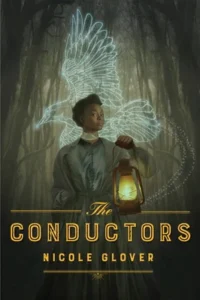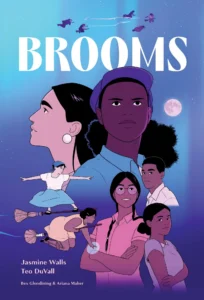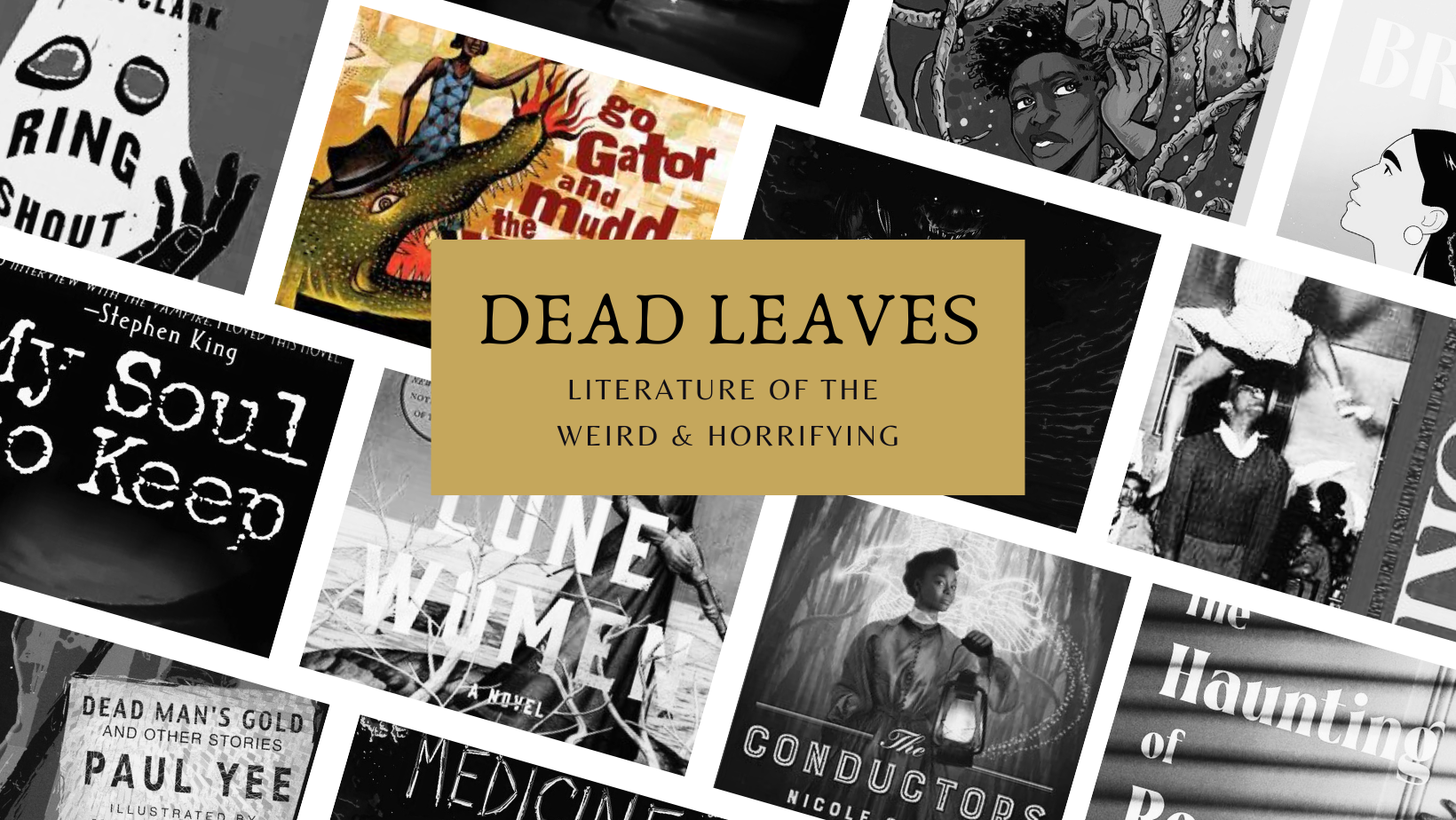Welcome to Dead Leaves, an occasional table stacked high with recent horror tomes! Today we offer a reading list in tribute to Sinners, the movie of the spring and now of the summer–probably the film of 2025. With fiction, nonfiction, and hybrid digital offerings, this survey has something for every reader who’s feeling sinful.
Sinners itself is a hefty tome, its generous run-time bursting with a multiracial cast, seamless deployment of musical numbers, and fully-realized time period and setting. Given the film’s references to the rich histories writer-director Ryan Coogler (Black Panther, Creed) is drawing from, it’s only natural to start with some light academia. Never fear: these suggestions are eminently readable if you’re not a history buff or culture hound.
Go Gator and Muddy the Water, a collection of Zora Neale Hurston’s writings from the Federal Writers Project, contains some of Hurston’s most crucial essays on African-American culture, religion, and everyday life. A Florida native and trained anthropologist, Hurston’s work on Black southern folklore is of particular interest to Sinners viewers. Also seeded throughout the book are examples of Black folk songs, dances, and the function of music in both mainline Black Protestant and sanctified churches. Check out the title essay for an in-depth examination of trickster tales that might make you look twice at twins Smoke and Stack (Michael B. Jordan), and “The Ocoee Riot” for an account of racial violence in a small Florida town.
 Trey Walk’s syllabus contains digital, print, and visual resources, creating an interdisciplinary and still-growing list suitable for a multifaceted film like Sinners. With suggestions for reading up on juke joints and the blues, Black spiritual and magical practices, and racial history, Walk’s list illuminates the movie’s major themes. The syllabus also maintains a great balance of open-access work, including photo essays and streaming documentaries, with academic reading, news articles, and popular fiction.
Trey Walk’s syllabus contains digital, print, and visual resources, creating an interdisciplinary and still-growing list suitable for a multifaceted film like Sinners. With suggestions for reading up on juke joints and the blues, Black spiritual and magical practices, and racial history, Walk’s list illuminates the movie’s major themes. The syllabus also maintains a great balance of open-access work, including photo essays and streaming documentaries, with academic reading, news articles, and popular fiction.
Many of the items included are in conversation not only with Sinners but with each other–see Up Jumped the Devil, about famed and mystical bluesman Robert Johnson, and Black Magic by Yvonne Chireau. Another online syllabus comes from the African-American Intellectual History Society and it’s seriously nitty-gritty. Some of the resources listed there will be easily accessible in public libraries or bookstores, and some might require flexing your research skills; it’s a great time to learn about interlibrary loan!
Best of all, the AAIHS syllabus includes examples of music and films inhabiting the same lexicon as Sinners. Now: were you drawn in by Miles Caton‘s mesmeric voice and slide guitar as youngblood Preacher Boy Sammie? Did you feel his inexorable pull to the juke and its sinful pleasures? If so, Jookin’ by Katrina Hazzard-Gordon is your book. Jookin’ focuses not only on free-range and makeshift dance-halls of historical Black culture, but also more the restricted, mainstream, and elite spaces of upwardly-mobile Black citizens. The tensions along this spectrum are reflected in Sammie’s journey from playing hymns in his father’s church to… well, you know.

For fictioneers, historical horror options for Sinners-adjacent themes and settings abound. Ring Shout, P. Djèlí Clark’s 2020 novella, will hit hard for audiences seeking southern Black settings and characters, melded with threats both supernatural and all too real. Ring Shout‘s Georgia locale, post-WWI time period, use of African-derived musical culture, and elegant marriage of white supremacy with demons strikes a number of chords similar to Sinners.
Another book set in 1915, Victor LaValle’s most recent novel Lone Women, is for the Annie and Mary stans. A little bit Western, a little bit noir, a whole lot horrifying: Lone Women delves into the westernmost tendrils of the Great Migration, exploring its affects on both Black families and Native people displaced by westward expansion. Sinners‘ core theme of generational trauma is mirrored in LaValle’s heroine Adelaide, who–like Annie (Wunmi Mosaku) and Mary (Hailee Steinfeld)–both carries burdens singular to Black women and packs a powerful punch.
Another powerful female protagonist is found in Nicole Glover’s Reconstruction-era mystery The Conductors. As genre-flexible as Sinners, The Conductors delivers a ghost story wrapped in a detective tale, both steeped in real Black history. The power of Black community, and the realities of white neglect and abuse of those communities, is on keen display in The Conductors.

Viewers heartbroken by Bo and Grace Chow’s fates (Yao and Li Jun Li) might be interested in Dead Man’s Gold, a short fiction collection written by Paul Yee and illustrated by Harvey Chan. Sinners’ multiracial town isn’t a-historical, as explicated here by Imani Perry, and its lauded centerpiece scenes are infused with multicultural richness. Relish Chinese mythology and ghost stories with Yee’s collection, and explore how immigrant tales are shaped by their receiving culture, and shape that culture in return.
Another group most first-time Sinners viewers probably didn’t expect to see are glimpsed briefly but maximize their screen-time: the Choctaw vampire hunters (including Nathaniel Arcand). Dive into Native and Indigenous lore, both modern-day stories and renderings of traditional tales, with graphic novels Brooms, Bad Medicine, and Trickster. The latter pairs nicely with readings on Black trickster figures, a narrative spot Smoke and Stack occupy, while Brooms features a Mississippi setting and both Black and Choctaw characters. Bad Medicine invites readers into contemporary Cree life with deliciously dark urban legends and tall tales, written and illustrated by Christopher Twin.
A third ethnic strand of Sinners’ complex braid is Jack O’Connell‘s Irish vampire Remmick. Remmick’s beguiling and yet avaricious nature speaks to the uneasy location of Irish identity within the American quilt. Most crucially, he’s a fiend for music, and it’s his fiendish weaponization of music that drives Sinners’ spin on vampire lore. The film uses its villain to play with serious themes of authenticity and appropriation; viewers still chewing on these topics a month later might be interested in The Beat Cop. Irish-American identity is a common enough one, with much political baggage, and Michael O’Malley’s book goes in-depth on the relationship between Irish-heavy police forces, internal policing of immigrant identity, and the morphing of traditional Irish music in the US.
 One of the Sinners hallmarks is its visual dexterity and interest both in the past and how our pasts echo forward into our futures. In this way, the film not only emphasizes and mythologizes the recent past, but reminds audiences to look around ourselves in the current day. What’s changed and what’s remained the same? What threads of historical horrors are still woven into our present?
One of the Sinners hallmarks is its visual dexterity and interest both in the past and how our pasts echo forward into our futures. In this way, the film not only emphasizes and mythologizes the recent past, but reminds audiences to look around ourselves in the current day. What’s changed and what’s remained the same? What threads of historical horrors are still woven into our present?
A wealth of contemporary spec-fic writers are grappling with these questions, as well as bringing under-sung fantastical elements and cultural lore to the forefront. Black vampires have steadily gained presence in the canon, from 1819’s “The Black Vampyre” to Blacula of the 1970s, Jewelle Gomez’s cornerstone collection The Gilda Stories, Aaliyah as Akasha in Queen of the Damned, and Jacob Anderson‘s star-making turn as Louis de Pointe du Lac in the latest iteration of Interview with the Vampire.
Black horror matriarch Tananarive Due’s My Soul to Keep is from 2011, but feels ever more fresh in the wake of Sinners, particularly in its examination of family ties and questions of (im)mortality. Out last week, Megan Giddings‘ latest book Meet Me at the Crossroads features twins embroiled in otherworldly machinations and possibilities, a la Smoke and Stack. If you’re still transfixed by the Bootsy Collins-esque figure shredding an electric guitar in the middle of the juke, reach for something just as vivid. After the Rain, written by John Jennings and illustrated by David Brame, adapts the Nnedi Okorafor story “On the Road” to exceptional effect. Caught between cultures and beset by magic from Nigerian myths, After the Rain‘s heroine walks many lines between worlds.
Similarly, the Sinners line-up are often forced to grapple with where they’ve come from and what powers might be vested in keeping them there. And until we get that companion film about the Choctaw vampire hunters, relish a fresh release from a Native American voice! NA and Indigenous authors, including Stephen Graham Jones, Jacy Morris, and Felix Blackwell, have been maximizing their horror lit foothold in recent years. Erika Wurth’s new book, The Haunting of Room 904, moves in modes that will delight Sinners aficionados: complicated sibling relationship? Check. Equally complicated relationship between past and present? Check. Skillful mirroring of personal hauntings with those of historical atrocities? Check!
DIS/MEMBER encourages readers to hit those links, support indie publishers, booksellers, and libraries, and explore the vast and labyrinthine intersections of horror, African-American culture, and US history. Happy reading, ghouls!

